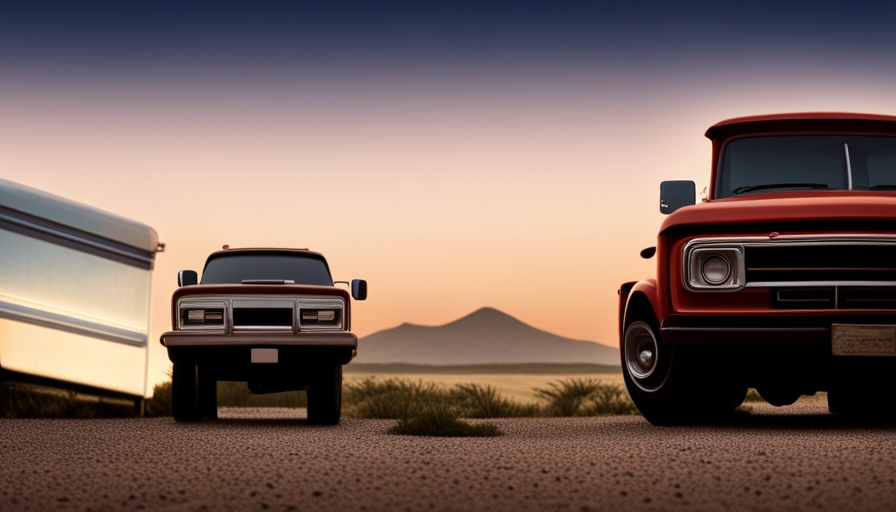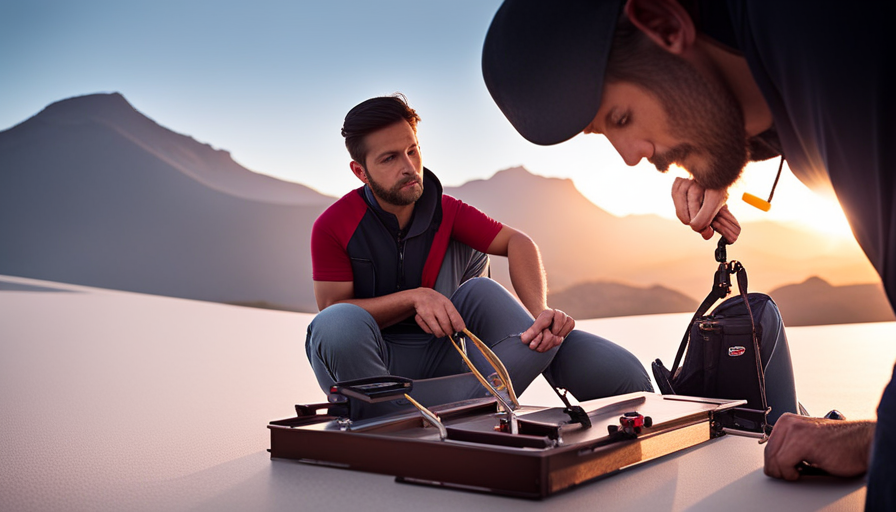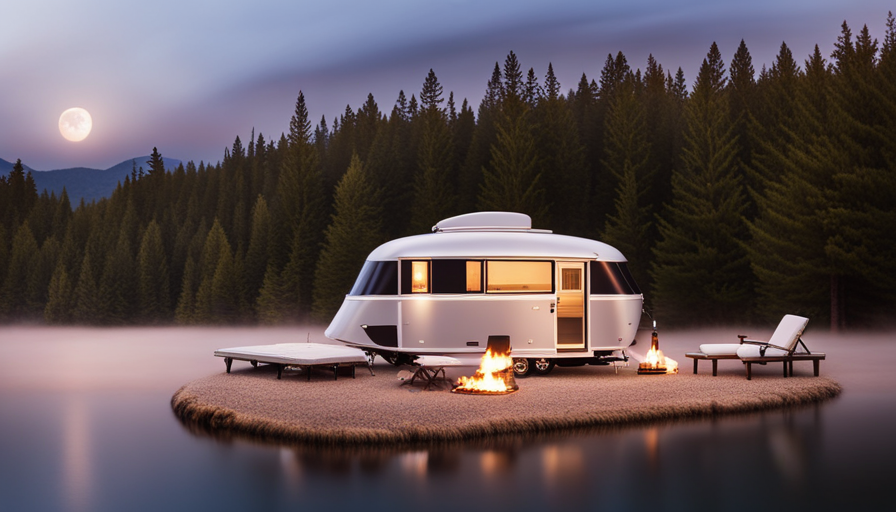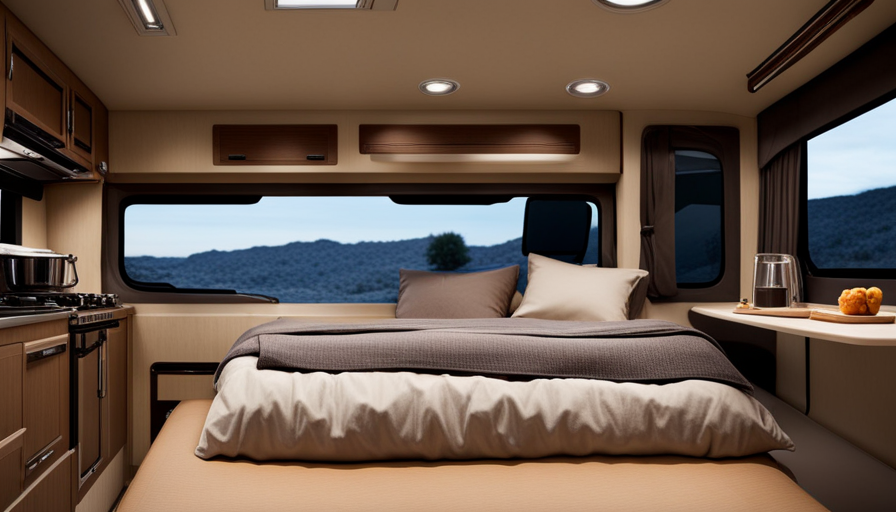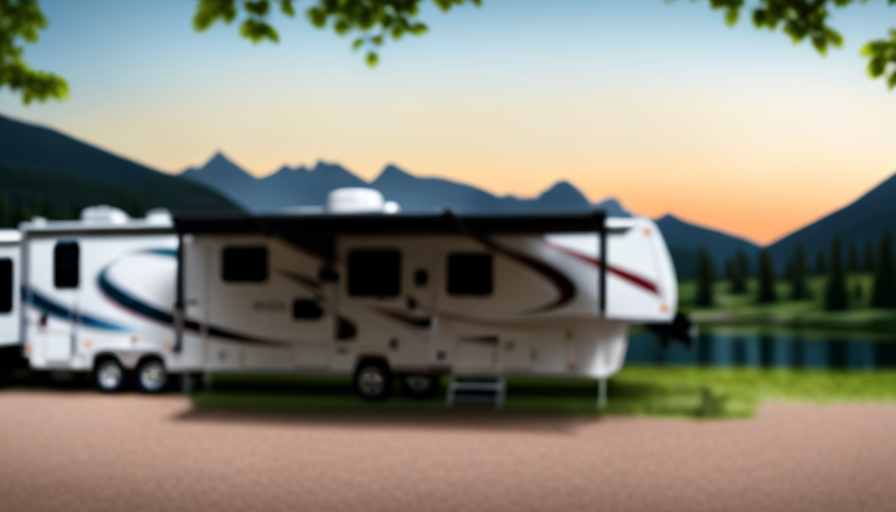You’ve made the exciting decision to venture out on your latest escapade, ready to explore the highways with your brand new 5th wheel camper trailing behind you. This thrilling expedition, whether it’s a family outing or a solitary quest for personal understanding, demands specific know-how and skills for towing a 5th wheel camper, ensuring your journey is both secure and pleasurable.
Let me paint a picture for you: Imagine you’re cruising down a scenic highway, surrounded by breathtaking landscapes, with the wind in your hair and the open road ahead. You feel confident and in control as you navigate the twists and turns, effortlessly maneuvering your 5th wheel camper behind you.
In this article, we will guide you through the essential steps to successfully tow a 5th wheel camper. From understanding the weight and size requirements of your vehicle to choosing the right hitch and practicing maneuvering techniques, we’ve got you covered.
So buckle up and get ready to learn the ins and outs of towing a 5th wheel camper like a pro.
Key Takeaways
- Understanding the weight and size requirements of your vehicle is crucial.
- Choose the right hitch for your 5th wheel camper based on your truck’s towing system.
- Maneuvering and backing up with a 5th wheel camper requires wider turns and awareness of length and height.
- Secure your 5th wheel camper properly by distributing weight evenly and securing cargo inside.
Understand the Weight and Size Requirements of Your Vehicle
Before you can start towing your 5th wheel camper, you need to understand the weight and size requirements of your vehicle. It’s crucial to know the weight restrictions and vehicle requirements to ensure a safe and smooth towing experience.
First, check your vehicle’s towing capacity, which can usually be found in the owner’s manual or by contacting the manufacturer. This will give you an idea of how much weight your vehicle can safely tow.
Additionally, consider the gross vehicle weight rating (GVWR) and the gross combined weight rating (GCWR) to determine if your vehicle is capable of handling the weight of your 5th wheel camper.
Furthermore, take into account the size requirements of your vehicle. Measure the length, width, and height of your camper to ensure that it is within the allowable dimensions for towing. Also, consider any additional equipment or cargo that’ll be added to your vehicle, as this can affect its towing capabilities.
Understanding the weight and size requirements of your vehicle is crucial for a successful towing experience. Once you have determined these requirements, you can move on to choosing the right hitch for your 5th wheel camper. This’ll ensure a secure and stable connection between your vehicle and camper, allowing you to tow with confidence.
Choose the Right Hitch for Your 5th Wheel Camper
First, make sure you’ve got the perfect hitch that will effortlessly connect your 5th wheel home away from home to your trusty truck.
Choosing a hitch for your 5th wheel camper is a crucial step in ensuring a safe and smooth towing experience. There are a few key factors to consider when selecting the right hitch. Firstly, you need to determine the weight capacity of your truck’s towing system. This information can usually be found in the owner’s manual or by consulting with a professional. Once you know the weight capacity, you can choose a hitch that’s capable of handling the weight of your 5th wheel camper.
Proper hitch installation is also essential for a secure connection between your truck and camper. It’s recommended to have a professional install the hitch to ensure it’s done correctly. The hitch should be properly aligned and securely attached to the truck’s frame. Additionally, the safety chains and electrical connections should be properly hooked up and tested before hitting the road.
With the perfect hitch in place, you can now transition into performing a pre-trip inspection of your vehicle and camper. This step is crucial for identifying any potential issues and ensuring a safe journey.
Perform a Pre-Trip Inspection of Your Vehicle and Camper
Now, take a moment to ensure your vehicle and home-away-from-home are in tip-top shape by performing a pre-trip inspection. Performing a pre-trip inspection is essential before hitting the road with your 5th wheel camper.
Not only does it guarantee a safe and smooth journey, but it also helps prevent potential issues and breakdowns along the way.
Start by checking the tires on both your vehicle and camper. Look for any signs of wear and tear, and ensure they’re properly inflated. Inspect the brakes, ensuring they’re functioning correctly and not worn out. Check all the lights, including headlights, taillights, and turn signals, to ensure they’re working properly.
Next, inspect the hitch, making sure it’s securely attached to your vehicle and the locking mechanisms are in good condition.
Don’t forget to examine the camper itself. Check the exterior for any signs of damage, such as loose panels or leaks. Inspect the roof and windows, ensuring they’re properly sealed. Inside the camper, check all appliances and systems, including the plumbing, electrical, and HVAC.
Performing a pre-trip inspection is crucial for the safety of you and your fellow travelers. It not only guarantees a smooth journey but also highlights the importance of proper maintenance. By taking the time to inspect your vehicle and camper before hitting the road, you can address any potential issues and ensure a worry-free adventure.
As we move on to the next section about practice maneuvering and backing up with your 5th wheel, remember that a thorough pre-trip inspection sets the foundation for a successful towing experience.
Practice Maneuvering and Backing Up with Your 5th Wheel
To truly master the art of maneuvering and backing up with your 5th wheel, picture yourself effortlessly gliding around tight corners and smoothly navigating into the trickiest of parking spots. It may seem daunting at first, but with the right techniques and tips, you can become a pro in no time.
When it comes to maneuvering your 5th wheel, one important technique is to take wider turns than you would with a regular vehicle. This allows your camper to follow the same path as your towing vehicle, preventing any unwanted collisions.
Additionally, always be aware of the length and height of your camper, as it can impact your ability to clear obstacles such as low bridges or overhanging branches.
Backing up with a 5th wheel requires a different approach compared to regular trailers. One useful tip is to place your hand at the bottom of the steering wheel and move it in the direction you want the rear of the camper to go. This helps create a smoother and more controlled backing up experience. It’s also helpful to have a spotter outside the vehicle to guide you and provide clear communication.
Now that you have mastered the maneuvering and backing up techniques, it’s time to ensure you secure your 5th wheel camper properly for safe towing.
Secure Your 5th Wheel Camper Properly for Safe Towing
Securing your 5th wheel properly is crucial for ensuring a safe and smooth towing experience. One of the key aspects of securing your 5th wheel camper is proper weight distribution. It’s important to distribute the weight evenly throughout the camper to prevent any instability during towing.
To achieve this, make sure that heavier items are placed towards the front of the camper and closer to the axle. This will help maintain a balanced weight distribution and reduce the risk of swaying or fishtailing while on the road.
In addition to weight distribution, securing your cargo inside the camper is vital. Before hitting the road, take the time to secure all loose items and ensure that cabinets and drawers are properly closed and latched. This will prevent any shifting or movement of items inside the camper while you’re on the move.
By properly securing your 5th wheel camper and distributing the weight evenly, you’ll have a safer and more stable towing experience.
Now that you have the proper setup, the next step is to adjust your driving habits for towing a 5th wheel camper. This will ensure that you’re able to navigate turns, stop safely, and maintain control of your vehicle and camper.
Adjust Your Driving Habits for Towing a 5th Wheel
When you’re behind the wheel of your truck, remember to adjust your driving habits for smooth and safe towing, just like a seasoned sailor navigating the open seas.
One of the crucial aspects of towing a 5th wheel camper is adjusting your speed appropriately. It’s important to drive at a moderate speed, ensuring that you have enough time to react to any unexpected situations on the road. Going too fast can increase the risk of losing control or experiencing sway, while driving too slow can impede traffic flow and cause frustration for other drivers. Finding the right balance is key.
Another aspect to consider is managing sway while towing. Sway refers to the side-to-side movement of the camper, which can be caused by various factors such as wind, uneven road surfaces, or improper weight distribution. To minimize sway, make sure to distribute the weight evenly in your camper and ensure that the load is properly secured. Additionally, consider using sway control devices like anti-sway bars or weight distribution hitches, which help to stabilize the camper and reduce sway.
As you adjust your driving habits and manage sway, it’s important to plan your route and be aware of height and weight restrictions. This will help you avoid any obstacles or hazards that could potentially cause damage to your camper or compromise your safety. So, buckle up and get ready to hit the road, but not before planning your route and being mindful of height and weight restrictions.
Plan Your Route and Be Aware of Height and Weight Restrictions
As experienced 5th wheel campers, we know that adjusting our driving habits is crucial when towing these large trailers. But there’s more to consider than just how we drive. Planning our route and being aware of height and weight restrictions is equally important for a smooth and safe journey.
Route planning is essential to avoid any unexpected surprises along the way. We always take the time to research and map out our route ahead of time, making sure to choose roads that are suitable for our 5th wheel’s height and weight. This includes being mindful of low bridges, narrow roads, and weight restrictions that may prohibit us from passing through certain areas.
Height restrictions can be a major concern when towing a 5th wheel. The last thing we want is to encounter a bridge or overpass that is too low for our camper to safely pass under. By carefully planning our route and being aware of height restrictions, we can avoid any potentially dangerous situations and ensure a smooth journey.
Now that we’ve covered the importance of route planning and height restrictions, let’s move on to the next section where we discuss how to take precautions for braking and stopping with a 5th wheel.
Take Precautions for Braking and Stopping with a 5th Wheel
Navigating the open road with a fifth wheel requires careful attention to braking and stopping, ensuring a safe and smooth journey. When towing a 5th wheel camper, it’s crucial to understand the braking techniques specific to this type of setup. Here are some key points to consider:
-
Make sure your trailer brakes are properly adjusted and in good working condition. This’ll help distribute the braking force evenly between the towing vehicle and the camper, reducing the risk of skidding or jackknifing.
-
Use the trailer brake controller to adjust the braking intensity. Gradually apply the brakes to avoid sudden stops or jerky movements, especially when going downhill.
-
When approaching a stop, start braking earlier than you would with just your towing vehicle. The added weight of the camper requires more time and distance to come to a complete stop.
-
Practice emergency stopping in a safe and controlled environment. Familiarize yourself with how your setup responds in sudden braking situations, and adjust your driving accordingly.
-
Always maintain a safe following distance to allow for ample stopping time. The heavier weight of a fifth wheel camper can increase stopping distances, so it’s important to be mindful of this.
Taking these precautions for braking and stopping will greatly enhance your towing experience. In the next section, we’ll discuss how to monitor and maintain your towing equipment and vehicle to ensure a safe and enjoyable journey.
Monitor and Maintain Your Towing Equipment and Vehicle
To ensure a safe and enjoyable journey, we need to keep an eagle eye on the health of our towing equipment and vehicle. Monitoring our equipment is crucial to prevent any potential issues that could arise during our trip.
Before hitting the road, we should thoroughly inspect our hitch, safety chains, and brake controller to ensure they’re in proper working order. It’s also important to regularly check the tire pressure and condition of both the towing vehicle and the camper. This will help us maintain stability and control while towing.
In addition to monitoring our equipment, regular vehicle maintenance is essential. We should schedule routine maintenance checks, including oil changes, tire rotations, and brake inspections. These precautions will help us identify and address any mechanical issues before they become more serious problems on the road.
By diligently monitoring our equipment and maintaining our vehicle, we can minimize the risk of unexpected breakdowns and ensure a smooth towing experience. However, even with proper monitoring and maintenance, emergencies can still occur. That’s why it’s crucial to be prepared for any towing issues that may arise and know how to troubleshoot them effectively.
Be Prepared for Emergencies and Know How to Troubleshoot Towing Issues
Make sure you’re ready for any unexpected incidents and have the knowledge to troubleshoot any issues that may arise while towing. When towing a 5th wheel camper, it’s crucial to be prepared for emergencies and know how to handle any potential problems that may occur on the road.
Understanding emergency procedures and having the necessary troubleshooting techniques can help ensure a safe and stress-free towing experience.
One important aspect of being prepared for emergencies is knowing what to do in case of a breakdown or accident. Familiarize yourself with the emergency procedures specific to your towing equipment and vehicle. This includes knowing how to safely park and secure your camper in case of a roadside emergency, as well as having the necessary tools and equipment to address minor issues on your own.
In addition, it’s essential to have troubleshooting techniques in your arsenal. Being able to diagnose and fix common towing issues can save you time and money. Familiarize yourself with common problems such as trailer swaying, brake failures, or tire blowouts. Learn how to properly inspect and maintain your towing equipment to prevent these issues from occurring in the first place.
By being prepared for emergencies and knowing how to troubleshoot towing issues, you can ensure a smooth and safe journey while towing a 5th wheel camper. Stay knowledgeable, experienced, and detailed in your approach, and you’ll be well-equipped to handle any situation that comes your way.
Frequently Asked Questions
What are the weight and size requirements for towing a 5th wheel camper?
When it comes to towing a 5th wheel camper, weight and size requirements are crucial. Safety is paramount, so knowing the weight requirements of your towing vehicle is a must. It’s vital to stay within the recommended weight limits to ensure stability and control on the road.
Additionally, understanding the size requirements of your camper, including height and width, will help you navigate through various terrains and avoid potential hazards.
How do I choose the right hitch for my 5th wheel camper?
Choosing the right hitch for your 5th wheel camper is crucial for a safe and smooth towing experience. Hitch compatibility is key when selecting the right hitch. Consider the weight rating, which should exceed the weight of your camper, as well as the type of hitch (such as gooseneck or fifth wheel).
Additionally, factors like bed length, towing vehicle’s capabilities, and ease of installation should be taken into account. It’s important to consult with experts or do thorough research to ensure a proper match.
What should I inspect during a pre-trip inspection of my vehicle and camper?
During a pre-trip inspection, my fellow travelers and I diligently go through a comprehensive checklist to ensure a safe journey. We inspect the tires for proper inflation and tread wear, the brakes for any signs of damage or wear, and the lights to ensure they’re functioning properly.
Additionally, we check the hitch and connections for any loose or damaged parts. We also pay close attention to common maintenance issues such as fluid levels, belts, and hoses. This meticulous inspection guarantees that our vehicle and camper are in top-notch condition for our adventure.
How can I practice maneuvering and backing up with my 5th wheel?
To practice maneuvering and backing up with our 5th wheel, we can employ various techniques.
First, we should find open spaces such as empty parking lots or large fields to avoid any potential obstacles.
Then, we can start by practicing basic turns, gradually increasing the difficulty level. It’s important to pay attention to the trailer’s pivot point and use small steering inputs to make precise adjustments.
With consistent practice, we’ll gain the confidence and skills needed to handle our 5th wheel with ease.
What precautions should I take for braking and stopping with a 5th wheel?
When it comes to braking and stopping with a 5th wheel, it’s crucial to employ proper techniques and be prepared for emergency situations.
Firstly, ensure you have a brake controller installed in your tow vehicle to effectively control the trailer brakes.
Practice gradual braking to avoid jerky stops and maintain control.
In emergency situations, apply steady and firm pressure to the brake pedal, activating both the tow vehicle and trailer brakes simultaneously.
Remember, maintaining a safe following distance is key to reacting and stopping in time.
What Are the Differences in Towing Techniques Between a Camper and a 5th Wheel Camper?
When it comes to towing a camper, there are distinct differences in techniques between a regular camper and a 5th wheel camper. The primary distinction lies in the way they connect to the towing vehicle. While a camper is towed using a hitch attached to the rear bumper, a 5th wheel camper requires a specialized hitch mounted in the bed of a pickup truck. This difference in setup affects the stability, maneuverability, and weight distribution, making it crucial for drivers to understand the disparities before embarking on their journey.
Conclusion
In conclusion, towing a 5th wheel camper requires careful planning, preparation, and attention to detail. By understanding the weight and size requirements of your vehicle, choosing the right hitch, and practicing maneuvering and backing up, you can confidently tow your camper.
It’s also important to secure your camper properly, plan your route, and take precautions for braking and stopping. Remember to regularly monitor and maintain your towing equipment and vehicle to ensure safe travels. And in case of emergencies, it’s crucial to be prepared and know how to troubleshoot towing issues.
Here’s an interesting statistic for you: Did you know that the average length of a 5th wheel camper is around 35 feet? That’s like towing a small house behind your vehicle! So, when you’re out on the road with your 5th wheel, take pride in your towing skills and enjoy the freedom and adventure that comes with it.
Safe travels!

